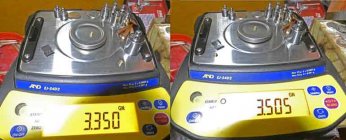@Hohn
I agree with consistency being key. Short term, during one reloading session, and long term for the next session. The reloader is the production staff and his own QC inspector and in many cases his own
metrologist. Believing instrument specifications without periodic checks and calibrations might get you safe results, maybe.
I'll use what I've learned about my newest scale, the EJ-54D2. Checks at several points over the instrument's range show it's repeatability and accuracy compared to check standards more accurate than the resolution of the scale. On that day, maybe next week. One day I'll probably be able to detect when the performance degrades using these highly stable check standards. The minimal user calibration procedure recommended by the scale manufacturer isn't going to monitor the true performance in my using environment.
So, to answer the original thread question,
How Much Precision in a Scale is Required for Precise Weight-Sorting
MORE precision than you REQUIRE, and that's on YOU to determine.
How about another Rocketvapor picture ?
Here's a result of using a cheap, old beat up digital scale.
Resolution of 0.01 gram in gram mode, 0.2 grains in grain mode.
Repeatability seems to be one count over several readings. I get 8.17grams with an occasional 8.16g.
I keep this one around just for sanity checks


Here are the values and avg from a previous post for the case in question #1 of six.
SIZED AND TRIMMED TO 22 NOSGAR 1.765"
1 8.1672 .1674 .1674 .1672 .1672
avg 8.16728
2 8.1694* .1692 .1692 .1690* .1692 .1692 avg 8.16920
3 8.1702 .1704 .1702 .1704 .1704 avg 8.17032
I wonder what case # 2 will weight on this scale?
UPDATE.
Case #2 shows 8.17, case 1 plus 2 shows 16.34g/16.33g
Case 1 + 2 +3 shows 24.51g
Not enough resolution to discern one case from another.
10g shows 10.00g
All 6 cases (49.021g) show 49.03 with an occasional 49.04 on this scale
Probably good enough for initial binning of cases to half a grain?














